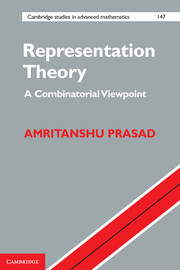Book contents
- Frontmatter
- Contents
- List of Tables
- Preface
- 1 Basic Concepts of Representation Theory
- 2 Permutation Representations
- 3 The RSK Correspondence
- 4 Character Twists
- 5 Symmetric Functions
- 6 Representations of General Linear Groups
- Hints and Solutions to Selected Exercises
- Suggestions for Further Reading
- References
- Index
6 - Representations of General Linear Groups
Published online by Cambridge University Press: 18 December 2014
- Frontmatter
- Contents
- List of Tables
- Preface
- 1 Basic Concepts of Representation Theory
- 2 Permutation Representations
- 3 The RSK Correspondence
- 4 Character Twists
- 5 Symmetric Functions
- 6 Representations of General Linear Groups
- Hints and Solutions to Selected Exercises
- Suggestions for Further Reading
- References
- Index
Summary
Polynomial Representations
We assume that K is an infinite field, so that there is no difference between formal polynomials and the functions that they give rise to.
Definition 6.1.1 (Polynomial representation). A polynomial representation of GLm(K) is a representation (ρ, V) of GLm(K), where V is a finite-dimensional vector space over K such that for each v ∈ V and ξ ∈ V′, the function
g ↦ 〈ξ, ρ(g)v〉
is a polynomial function in the entries of the matrix g. If, for all ν ∈ V and ξ ∈ V′, this polynomial is homogeneous of degree n, then (ρ, V) is said to be a homogeneous polynomial representation of degree n.
Here, as usual, V′ denotes the space of K-linear maps V → K.
[1] Exercise 6.1.2. A representation (ρ, V) is a polynomial representation if and only if, for any basis e1, …, em of V, taking ξ1, …, ξm to be the dual basis of V′, the function
g ↦ 〈ξi, ρ(g)ej〉
is a polynomial function of the entries of g for all i, j ∈ {1, …, m}. Furthermore, ρ(g) is homogeneous of degree d if and only if the polynomial in (6.1) is homogeneous of degree d for all i, j ∈ {1, …, m}.
Example 6.1.3 (The defining representation of GLm(K)). Let V = Km. View the elements of V as column vectors and let g ∈ GLm(K) act on ν ∈ V by ρ1(g)ν = gν (matrix multiplication). Taking ei to be the basis of Kn given by the coordinate vectors,
〈ξi, ρ1(g)ej〉 = gij,
where gij is the (i, j)th entry of the matrix g ∈ GLm(K). Therefore, (ρ1, Kn) is a homogeneous polynomial representation of GLm(K) of degree 1. It is often called the defining representation of GLm(K).
Example 6.1.4 (The determinant). The determinant function GLm (K) → K* is a multiplicative character which is also a polynomial of degree m in the entries.
Information
- Type
- Chapter
- Information
- Representation TheoryA Combinatorial Viewpoint, pp. 141 - 159Publisher: Cambridge University PressPrint publication year: 2015
